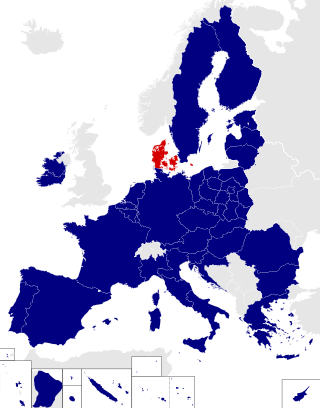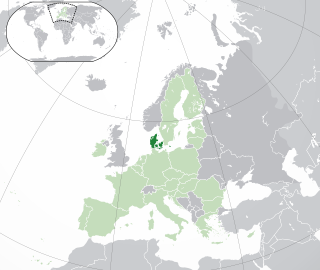The politics of Greenland, an autonomous country within the Kingdom of Denmark, function in a framework of a parliamentary representative democratic dependency, whereby the prime minister is the head of government, and of a multi-party system. Executive power is exercised by the government. Legislative power is vested in both the government and parliament Inatsisartut. The judiciary is independent of the executive and the legislature. Greenland has full autonomy on most matters, except on policies and decisions affecting the region including negotiations with the devolved legislatures and the Folketing.

There are three types of elections in Denmark: elections to the national parliament, local elections, and elections to the European Parliament. Referendums may also be called to consult the Danish citizenry directly on an issue of national concern.

This is a list of referendums related to the European Union, or referendums related to the European Communities, which were predecessors of the European Union. Since 1972, a total of 48 referendums have been held by EU member states, candidate states, and their territories, with several additional referendums held in countries outside the EU. The referendums have been held most commonly on the subject of whether to become a member of European Union as part of the accession process, although the EU does not require any candidate country to hold a referendum to approve membership or as part of treaty ratification. Other EU-related referendums have been held on the adoption of the euro and on participation in other EU-related policies.

Article 50 of the Treaty on European Union (TEU) provides for the possibility of an EU member state leaving the European Union "in accordance with its own constitutional requirements".

Greenland, an autonomous territory within the Kingdom of Denmark is one of the EU members’ overseas countries and territories (OCT) associated to the European Union. Greenland receives funding from the EU for sustainable development and has signed agreements increasing cooperation with the EU.

The 1979 European Parliament election was a series of parliamentary elections held across all 9 European Community member states. They were the first European elections to be held, allowing citizens to elect 410 MEPs to the European Parliament, and also the first international election in history.

Between 1973 and 1993 the European Communities saw the first enlargement of the Communities. On 1 January 1973, Denmark, Ireland, and the United Kingdom became the first countries to join the Communities. The détente allowed initiation of the reunification of the continent through establishing the Conference on Security and Co-operation in Europe. Greece was the next to join EC on 1 January 1981, followed by Spain and Portugal joining on 1 January 1986, while Turkey has initiated the procedure in 1987. Upon the fall of the Iron Curtain, the CSCE was transformed in 1990 into Organization for Security and Co-operation in Europe, the Communities enlarged for a fourth time through the German reunification, while other former communist European countries stated their firm commitment to join, prompting formulation of the Copenhagen criteria. This period was, however, also the one which witnessed the first voluntary exit from the Communities, namely the one of Greenland in 1985. The integration progressed under the Delors Commission resulting in the creation of the European Union in 1993.

The Danish Realm, officially the Kingdom of Denmark, or simply Denmark, is a country and refers to the area over which the monarch of Denmark is head of state. It consists of metropolitan Denmark—the kingdom's territory in continental Europe and sometimes called "Denmark proper" —and the realm's two autonomous regions: the Faroe Islands in the North Atlantic and Greenland in North America. The relationship between the three parts of the Kingdom is also known as The unity of the Realm.

Denmark is a European Parliament constituency for elections in the European Union covering the member state of Denmark, but not other parts of the Danish Realm such as the Faroe Islands or Greenland, which are not part of the EU. It is currently represented by fourteen Members of the European Parliament. Denmark uses the D'Hondt method of proportional representation. Electoral coalitions between two or more parties are allowed.
A referendum on continued membership of the European Communities (EC) was held in Greenland on 23 February 1982.
Hokonui was a parliamentary electorate in the Southland region of New Zealand, from 1881 to 1890.
The Greenland Provincial Council was the provincial government of Greenland between 1950, when it was formed from the union of the earlier North and South Greenland Provincial Councils, and 1 May 1979, when it was replaced by the Greenland Home Rule Government and its Parliament.

Denmark in the European Union refers to the historical and current issues of Denmark's membership in the European Union (EU). Denmark has a permanent representation to the EU in Brussels, led by ambassador Jonas Bering Liisberg.

Atassut is a liberal-conservative and unionist political party in Greenland. Founded on 29 April 1978, Atassut is an established partner of the Liberal Party of Denmark.
Finn Lynge was a Greenlandic politician, Indigenous rights activist, priest and civil servant who from 1979 until 1984 was the sole Member of the European Parliament for Greenland. Lynge campaigned for Greenland's withdrawal and his seat was abolished when Greenland withdrew from the European Communities.

After being a part of the European Communities (EC) for twelve years, Greenland withdrew in 1985. It had joined the EC in 1973 as a county of Denmark, even though a majority in Greenland was against joining. In a consultative referendum in 1982, 53% of the electorate of Greenland voted to withdraw from the Communities. This latter referendum became possible after the introduction of home rule in Greenland in 1979. Following its withdrawal, which was regulated through the Greenland Treaty, the relationship between Greenland and the EC was partly settled through an association under Overseas Countries and territories (OCT) status. In recent years, the Greenlandic withdrawal from the European Communities has marginally been referred to as "Greenxit".
An election was held in Greenland in 1984 to elect its delegation to the European Parliament. This was the last election that Greenland took part in prior to the secession of Greenland from the European Union in 1985.
The Greenland Representation to the European Union in Brussels is the official representative office of Greenland to the European Union. The Greenland Representation to the European Union was established in 1992 in connection to the Royal Danish Embassy in Belgium. Greenland Representation to the European Union is located together with The Royal Danish Embassy, and the Mission of the Faroes to the European Union.

Greenland is one of the 12 multi-member constituencies of the Folketing, the national legislature of the Kingdom of Denmark. The constituency was established in 1975 following the merger of the two constituencies that covered Greenland. The constituency currently elects two of the 179 members of the Folketing using the open party-list proportional representation electoral system. At the 2022 general election it had 41,305 registered electors.










